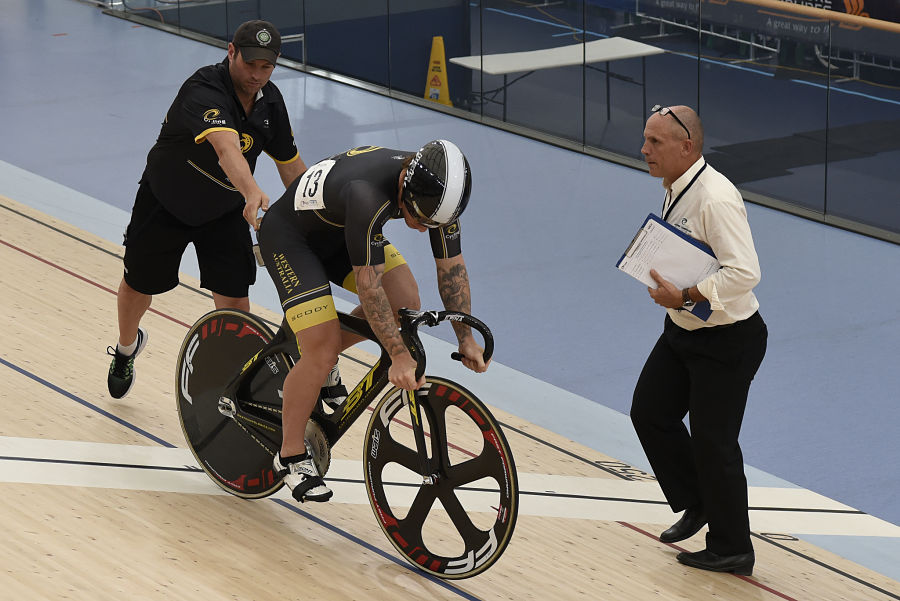With five WA cyclists this week announced on the Australian Junior Track World Championship long team, WAIS head coach Clay Worthington has highlighted the importance of a connected team approach.
The concept of culture within a sporting context is perhaps one of the most overused or at least simplified elements that is regularly attributed to success. Yet within a high performance hub such as the WA Institute of Sport, it is the ability to draw on common, shared themes that has driven a template for excellence within the track cycling network.
Following a successful campaign at the recent track championships in Brisbane, WA saw Sam Welsford and Cam Meyer selected for the senior team to tackle the Track World Championships in Hong Kong in April, before Kye Bonser, Matthew Richardson, Jade Haines, Tyler Lindorff and Conor Leahy were this week added for the junior campaign in China, next August.
Clay Worthington and senior coach Andrew Jackson have spearheaded the successful program that will see WA equal its highest representation at a junior track level, if all five members are retained in the final world championship squad.
“We’re ecstatic,” Worthington said of the long team result. “That ties the most number that WA has ever sent to a junior worlds. The last time I think was Mexico (2007).”
“There are a large number of support structures that are represented in that number. It’s been a village that has put this team together.”
The support structure observed, is centralised by a Performance Enhancement Team that combines elements such as sports science, physical conditioning and medical services around a targeted, athlete focused philosophy.
Worthington argues that while results are all important, athletes too, need to feel a sense of purpose towards their work.
“Ultimately we understand that the gold standard of performing is the gold standard. We can’t shy away from that, it’s high performance sport,” he said.
“We want it to be an enjoyable thing. We charge the athletes with responsibility to create an environment that they want to spend time in. It should be a lifestyle, it should be a long term sustainable thing, if they’re going to have success and are going to achieve the goals that the program exists to achieve.”
The importance of the athlete focus can’t be underestimated in this approach. The WAIS cycling program has embraced WA champions such as Peter Dawson and Darryn Hill – who have both given freely of their time in a coaching/mentor capacity to enhance Western Australia’s emerging generation of talent – whilst senior athlete Cameron Meyer recently drove an initiative that was influential in ensuring the WAIS group was in peak form for nationals.
In the week preceding the track championships, the WA team held an open trials day, inviting WAIS staff and athletes from other WAIS program sports – to the Midvale SpeedDome as the cyclists prepared in simulated race conditions, to generate a more authentic competition environment.
“It was actually Cam’s idea and we were actually going to try and do this in October but for one reason or another it didn’t really come together until just before nationals. But from Cam’s way of thinking, it was really how can we make this event important? If we make it just like another training session, then it is just another training session,” Worthington explained.
“We’re trying to get these others to come out, and to their credit they do come out and our guys just perk up and they think, well, this is important and this person recognises that this is important to me and so there’s just that shared journey and shared culture.”
Worthington reasoned that the higher athlete empowerment had stemmed from the broader opportunities presented by the WAIS High Performance Service Centre training base in Mt Claremont.
“How do we get the benefit of this (facility)? Because the benefit isn’t in shiny new weights or a shiny new facility, the real magic of it is in that culture of interaction and in that culture of being recognised by your peers who you respect, because they’re doing hard things and fronting up to hard challenges and you’re doing the same,” he said.
“They just want to be successful at their core. Ok, that might be javelin, or it’s in field hockey or it’s in swimming but at its core it’s the same goal,” he said of the linked athlete focus at WAIS.
The rub-off of this approach at trials day was a tangible sense of team momentum that carried through to Brisbane.
“We had a number of pbs on the day which they could take forward to nationals. We had some who didn’t necessarily set pbs but did better than they expected and Cam was one of those. So then he’s thinking oh wow, I’m on, I’m definitely in shape to have a good nationals.”
“It was a great idea from Cam and the way that we executed it and the support that we got from WAIS, from staff and also the athletes made it what it was.”
If culture is indeed difficult to define, then perhaps results best speak for themselves.
Photo: (c) Tim Blake


